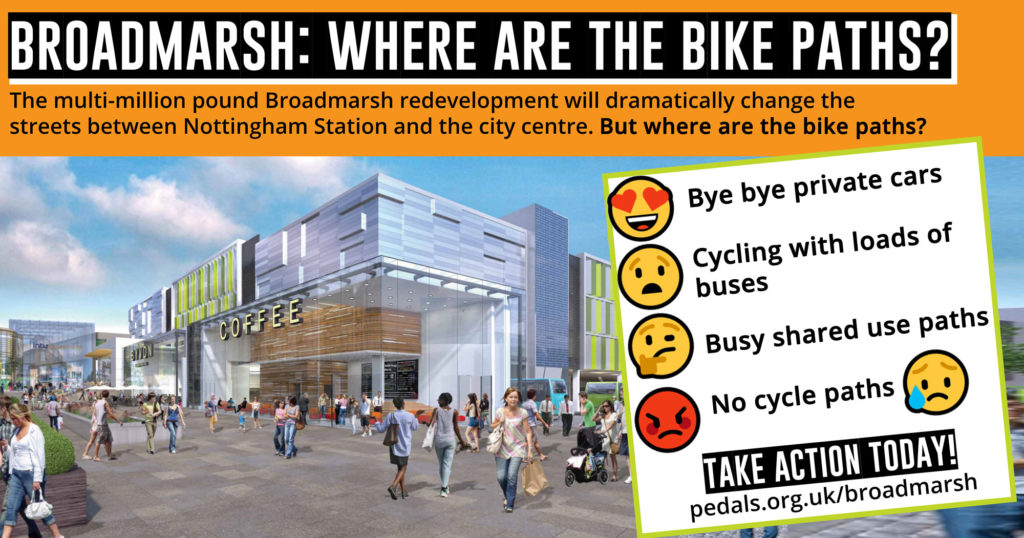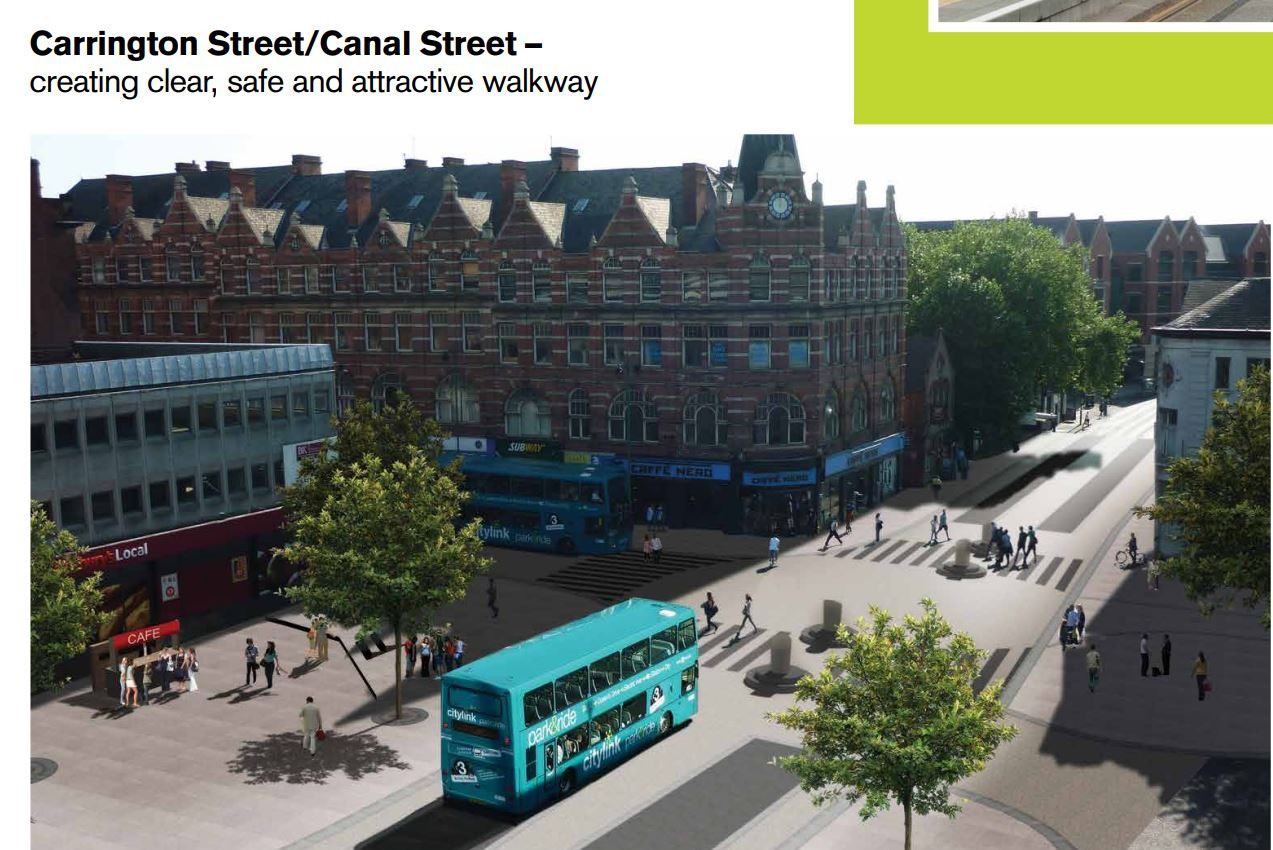
This is a summary of the scheme from a cycling perspective. You can read more about the road layout changes on the Transport Nottingham website here.
Please write to your councillors today about this scheme.
Reclaiming loads of space from cars
We strongly support the plan to remove private motor traffic from Canal Street (routed away along a new road to the south). It will become ‘bus only’ and go down from between 3 and 6 lanes to 2.

The Canal Street multilane mega road which cuts off Nottingham Station from the city centre will be tamed

Artists impression of Canal Street closed to private motor traffic – becoming bus only
BUT no protected cycle routes, plus people are expected to cycle with lots of buses
The designs expect people to cycle on the road with buses along the city’s main bus corridor. Having to ride on the road with significant numbers of buses doesn’t create an environment which will enable more people to cycle. (Think about how many buses use the junction outside the Victoria Centre and what it’s like.)

The plan: There’s LOADS of space, so why are people being forced to ride with buses?
This major development should create protected cycle routes to give all kinds of people the confidence to make their journeys by bike, not only the fast, fit and brave. With this much space available, a world class cycling environment should be easy.

A good solution: Room for a 2-way protected cycle path without taking space away from people walking. Not what is planned.
Can you imagine cycling to the new Central Library with young children and taking them on the road with buses? People will not choose to cycle if they are asked to cycle around double decker buses outside the city’s busiest bus station. Even if you feel confident cycling with buses, think about your friends and family who don’t cycle.
Multi Lane roundabouts are not fit for cycling
The junction of Middle Hill and Canal Street will change into a multi lane roundabout. This roundabout will be used by car park traffic.
People cannot be expected to cycle on multi lane roundabouts, they are intimidating and hazardous. 75% of reported pedal cycle casualties happen within 20 metres of a junction (GB 2011-2016, Department for Transport) which is why well-designed protection at junctions is so important.

Designing multi lane roundabouts into new schemes without separate protected cycle lanes is wrong.
This design fails to consider students cycling to college, commuters cycling to the railway station, and shoppers and families cycling to the new Broadmarsh cycle parking.
Walking and cycling routes are stop-start and poorly designed
At the junction of Canal Street and Carrington Street, people cycling (on the road, with all the buses) are expected to ride up onto shared use pavement sections. This will be a busy walking route from the city centre to the train station and bus station. People cycling will not be able to get onto these sections when lots of people are waiting at the crossings.
Shared use paths can be appropriate along very quiet routes where not many people walk, or as an interim step to something better. They are simply not appropriate along busy walking and cycling routes such as this.

Junction of Canal Street (horizontal) and Carrington Street (bottom). Red = footway, no cycling allowed. Blue = shared use, cycling allowed.
Shared use paths create conflict
Although people walking and people cycling are both vulnerable road users and need protection from motor traffic, the way each moves is very different. People cycling are able to go a lot faster, and even if cycling as courteously as possible, can be intimidating for people walking, especially on cramped paths with obstructions and poor visibility. The shared use sections of the Western Cycle Corridor outside the QMC are already busy and confusing. They are frustrating for people cycling and intimidating for people walking.
Putting people walking and people cycling onto the same paths shows a total lack of regard for the two groups’ very different needs. We need journeys to be safe, convenient and enjoyable for both people who walk and people who cycle. The solution is separate protected cycling infrastructure just like that which has been built along the A6005 Castle Boulevard section of the Western Cycle Corridor.
Joining up to the Castle Boulevard Cycle Path
In this scheme, the planned cycling routes are an afterthought (they are just a choice between pavements with added shared use signs or riding on the road, or a bit of both). They are fiddly, slow and involve stopping, starting and waiting at multiple crossings.
When people cycle east along the Western Cycle Corridor, they will have to wait at 3 or 4 road crossings in order to continue straight on along Canal Street towards the bus station or train station. This is in stark contrast to the rest of the Western Cycle Corridor route where people cycling are given priority.

Connecting to the protected cycle path on Castle Boulevard (arrows going left to right = heading east to go to the bus, train station or new Central Library, arrows going right to left = heading west to join the Western Cycle Corridor)
None of the toucan crossing islands are big enough for people cycling to safely wait on. When there are more than a couple of people cycling, people will simply not be able to fit.
This area should join up to the world class stretch of the Western Cycle Corridor cycle route on the A6005 Castle Boulevard (and the decent quality Eastern Cycle Corridor all the way along the A612 Daleside Road to Station Street), but it doesn’t.
Better is possible
Nottingham has good examples of well designed protected cycle routes and junctions for cycling, these should be replicated in the Broadmarsh scheme.
The brilliant Western Cycle Corridor protected cycle path along the A6005 Castle Boulevard should be extended with a high quality link to the station. This well designed route is just a few hundred meters away and according to Transport Nottingham traffic counters recorded around 1,000 cycle journeys per day and usage growing year on year. More of this please.
In order for large numbers of people to decide to cycle for their journeys, there needs to be a network of high-quality cycling routes like these, that connect all of the places people want to go. Disconnected fragments are not enough.

A good junction for cycling on Castle Boulevard a few hundred meters away. People walking and people cycling and are kept separate, protected from motor traffic and each understands where they need to go.
Instead, the Broadmarsh scheme looks like it was designed in the ‘90s, using unpopular shared use footpaths and multistage toucan crossing designs. What an absolute missed opportunity.
This scheme is designed to standards which are already out-dated and obsolete, before it has even been built. It will not help Nottingham City Council meet its own ambitious targets for increasing the number of people cycling for everyday journeys.
Please write to your councillors today about this scheme.